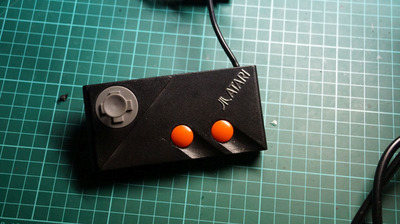eddman wrote on 2024-01-21, 11:48:
I remember using one on my 2600 as a kid and there are many posts on the internet about them working just fine, however, I recently came across a pin table and apparently the 5V pin is different between them.
https://en.wikipedia.org/wiki/Atari_joystick_ … patible_systems
How is having the power on a different pin not an issue? Wouldn't it cause damage over time?
The 2600 set a base standard for 9 pin controllers with only 1 button, but when companies started adding buttons they did it in different, incompatible ways.
An Atari console puts +5V on pin 7. The Sega Master System either didn't use this pin or used it for the light gun (depending which source I believe). SMS controllers don't care about +5V on this pin.
The Sega Genesis/MD controller uses pin 7 as the "Select" pin. This allowed Sega to add 2 more buttons. If that pin is high (5V) then the controller will return the states of buttons B and C. If that pin is low then it returns the states of buttons A and Start.
Since an Atari will always hold that pin high (5V), this simply means that the controller will be stuck only returning the state of B and C, along with the directionals. This is harmless.
B is the only action button that an Atari 2600 will be able to read. C is wired to pin 9, which I think is not connected to anything on a 2600, or at least not in a way that Atari games will see it.
It is possible for an Atari 7800 to read button C, but it requires unconventional programming (the signal looks weird from a 7800's point of view). Real published games will not see it because they weren't programmed for it. It is not possible for a 7800 to see buttons A or Start because they can't toggle the "Select" pin (pin 7). It is fixed at +5V on the 7800 just like on the 2600.
The Sega "6-button" controller (really 8 buttons) adds more complexity, but I don't think it changes anything as far as interfacing with an Atari. B will work, the other buttons won't.
Jo22 wrote on 2024-01-22, 07:53:There was a gamepad for the Atari 2600 Jr. that looks like the Sega Master System pad.
It may works on the Atari ST, too.
The p […]
Show full quote
There was a gamepad for the Atari 2600 Jr. that looks like the Sega Master System pad.
It may works on the Atari ST, too.
The pad is quite common here in Europe.
That thumb joystick can be removed, so you have an ordinary d-pad.
That's designed as an Atari 7800 controller, but they may have also distributed it with 2600Jr consoles. It's much more common in Europe than in the US. The US mostly got the "ProLine" 2 button joystick which sucked. That 2 button gamepad controller came later and replaced it.
A minor advantage of the 7800 controller is that a 2600 will see both buttons. Atari wired it so that both buttons activate the 2600 button signal, but also send a separate signal that a 7800 can use to distinguish the buttons from each other. With a Sega controller, only 1 of the buttons will be seen by an Atari.
I don't know how things work with the ST.
